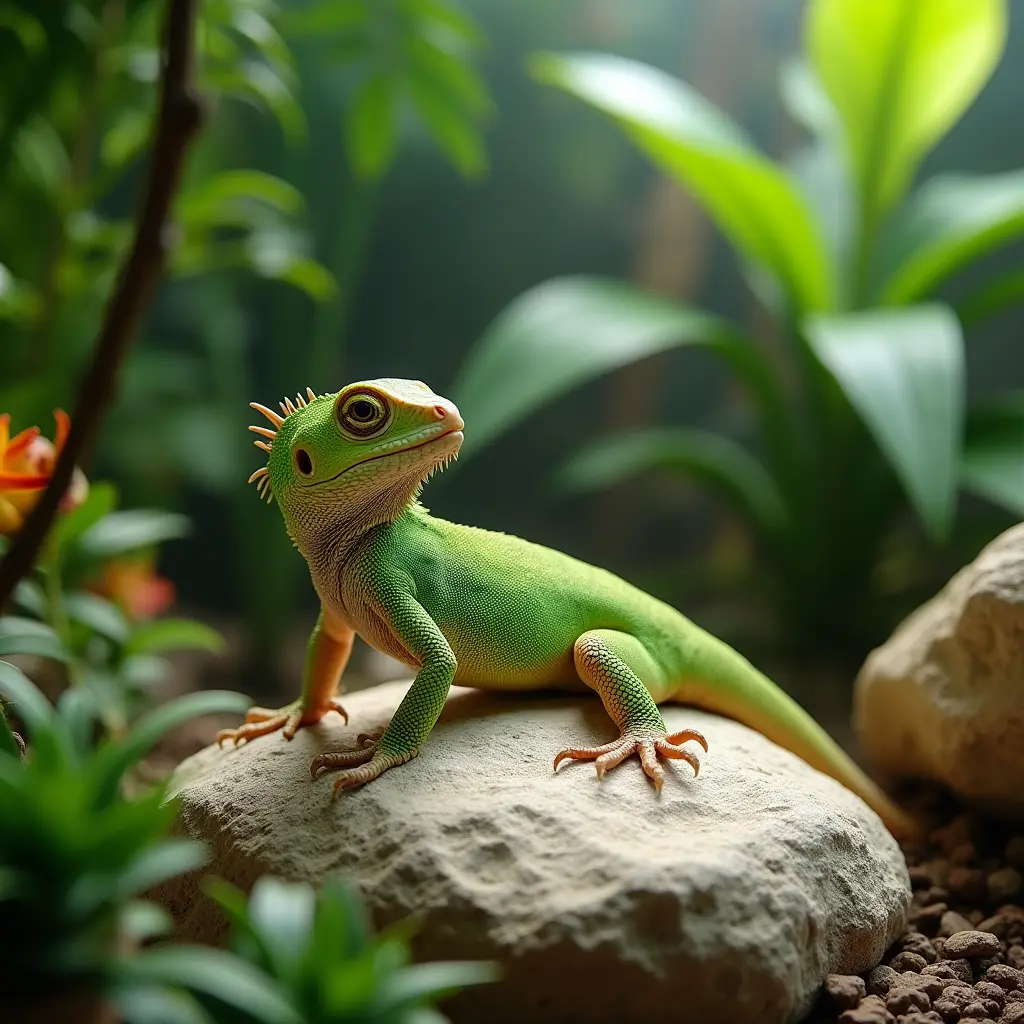Introduction
Baby iguanas are adorable, fascinating reptiles that require specialized care to thrive. As they are delicate in their early stages, proper attention to diet, habitat, and health is crucial. Whether you’re a new pet owner or an enthusiast, this guide covers everything you need to know about raising a healthy and happy baby iguana.
Table of Contents
1. Understanding Baby Iguanas
he, often referred to as hatchlings, are born small and vulnerable, measuring about 6-8 inches from head to tail. Native to Central and South America, they thrive in tropical environments.
- Lifespan: With proper care, iguanas can live up to 20 years, but the early stages are critical for their survival.
- Growth Rate: Baby iguanas grow quickly, requiring consistent attention to their diet and environment.
2. Setting Up the Perfect Habitat
Creating a suitable enclosure is vital for a baby iguana’s health and comfort.
A. Enclosure Size
- For hatchlings, a terrarium of at least 20-30 gallons is sufficient initially.
- As they grow, transition to larger enclosures to accommodate their size and activity.
B. Temperature and Lighting
- Temperature: Maintain daytime temperatures of 85-90°F and nighttime temperatures of 75-80°F.
- UVB Lighting: Baby iguanas need UVB light for vitamin D synthesis and calcium absorption, essential for bone health.
C. Humidity Levels
- Keep humidity levels between 65-80% to mimic their tropical habitat. Use a hygrometer to monitor levels and mist the enclosure daily.
3. Baby Iguana Diet
A proper diet is essential for the growth and health of baby iguanas.
A. Leafy Greens (Primary Diet)
- Collard greens, mustard greens, dandelion greens, and turnip greens should make up the bulk of their diet.
B. Vegetables and Fruits (Supplementary Foods)
- Offer vegetables like bell peppers, squash, and carrots.
- Fruits like mango, papaya, and strawberries can be occasional treats.
C. Calcium Supplementation
- Sprinkle calcium powder on their food 3-4 times per week to support bone development.
D. Hydration
- Baby iguanas get much of their water from their food, but always provide fresh water in a shallow dish.


4. Handling and Socialization
Baby iguanas need gentle handling to build trust and reduce stress.
A. Start Slowly
- Allow them to acclimate to their environment before attempting to handle them.
- Begin with brief, gentle interactions.
B. Be Consistent
- Regular handling helps them become accustomed to human interaction.
C. Avoid Stressful Situations
- Never force handling, as this can lead to aggression or fear.
5. Common Health Concerns
Baby iguanas are prone to certain health issues that require prompt attention.
A. Metabolic Bone Disease (MBD)
- Caused by calcium deficiency or lack of UVB exposure.
- Symptoms: Weak bones, lethargy, or deformities.
- Prevention: Proper diet and UVB lighting.
B. Parasites
- Parasites can cause weight loss and digestive issues.
- Regular veterinary checkups can help detect and treat infestations.
C. Respiratory Infections
- Symptoms: Wheezing or nasal discharge.
- Prevention: Maintain proper temperature and humidity levels.


6. Monitoring Growth and Behavior
Regular observation of your baby iguana can help identify potential issues early.
A. Healthy Growth
- A healthy baby iguana will grow steadily, gaining size and weight each month.
- Keep a log of their growth to ensure they’re developing properly.
B. Behavioral Signs of Health
- Active movement, a good appetite, and bright eyes indicate a healthy iguana.
- Lethargy or refusal to eat may signal a problem.
7. Enrichment and Mental Stimulation
Keeping your baby iguana mentally stimulated helps prevent boredom and promotes natural behaviors.
A. Climbing Structures
- Provide branches and platforms for climbing.
B. Hiding Spots
- Offer hiding spots like caves or plants to make them feel secure.
C. Interaction
- Spend time near their enclosure, allowing them to observe you.


8. Long-Term Care Transition
As your baby iguana grows, their needs will change.
A. Upgrading the Enclosure
- Move to a larger terrarium (at least 75 gallons) as they grow.
B. Adjusting Diet and Feeding Schedule
- Continue with a plant-based diet but adjust portion sizes and feeding frequency.
C. Veterinary Care
- Schedule annual vet visits to ensure their ongoing health.
Conclusion
Caring for a baby iguana requires dedication and attention to detail, but the rewards are immense. By providing the right habitat, diet, and care, you can ensure your baby iguana grows into a healthy, thriving adult. These fascinating reptiles can become long-term companions with the right care, making your efforts truly worthwhile.
1 thought on “Baby Iguana Care: 10 Proven Tips for a Healthy Start”